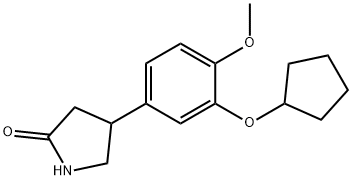61413-54-5
 61413-54-5 結(jié)構(gòu)式
61413-54-5 結(jié)構(gòu)式
基本信息
諾普利蘭
ZK-62711
ROLIPRAM
Roliprame
ROLIPRAM 98+%
(R,S)-Rolipram
Rolipram, >=97%
ZK-62711, SB95952, ME-3167
4-(3-(cyclopentyloxy)-4-methoxyphenyl)-2-pyrrolidinon
4-(3-(CYCLOPENTYLOXY)-4-METHOXYPHENYL)PYRROLIDIN-2-ONE
物理化學(xué)性質(zhì)
ethanol: 7mg/mL
DMSO: 7.3mg/mL
安全數(shù)據(jù)
| 報(bào)價(jià)日期 | 產(chǎn)品編號(hào) | 產(chǎn)品名稱 | CAS號(hào) | 包裝 | 價(jià)格 |
| 2025/02/08 | HY-16900 | 諾普利蘭 Rolipram | 61413-54-5 | 1 mg | 156元 |
| 2025/02/08 | HY-16900 | 諾普利蘭 Rolipram | 61413-54-5 | 5 mg | 312元 |
| 2025/02/08 | HY-16900 | 諾普利蘭 Rolipram | 61413-54-5 | 10mg | 500元 |
常見問(wèn)題列表
| Target | Value |
|
PDE4B
(Cell-free assay) | 130 nM |
|
PDE4D
(Cell-free assay) | 240 nM |
The PDE4 selective inhibitor, Rolipram, inhibits immunopurified PDE4B and PDE4D activities similarly, with IC 50 s of approx. 130 nM and 240 nM respectively. In contrast, Rolipram inhibits immunopurified PDE4A activity with a dramatically lower IC 50 of around 3 nM. Rolipram increases phosphorylation of cAMP-response-element-binding protein (CREB) in U937 cells in a dose-dependent fashion, which implies the presence of both high affinity (IC 50 approx. 1 nM) and low affinity (IC 50 approx. 120 nM) components. Rolipram dose-dependently inhibits the IFN-gamma-stimulated phosphorylation of p38 MAPK in a simple monotonic fashion with an IC 50 of approx. 290 nM. Rolipram is a selective PDE4 inhibitor that inhibits all PDE4 isoforms A, B, C and D. Rolipram inhibits LPS-induced TNF production in a dose-dependent manner (IC 50 25.9 nM), and maximal/submaximal inhibition is observed with 2 μM drug concentration in J774 cells.
TNF mRNA and protein expression is induced by LPS in peritoneal macrophages (PM) from WT mice, and that is clearly (by 74 and 63% for TNF mRNA and TNF protein, respectively) inhibited by Rolipram. LPS-induced TNF production is enhanced in PM from MKP-1(-/-) mice as compared to that in PM from WT mice, which is in line with the published results. Interestingly, the inhibition of TNF mRNA and protein expression by Rolipram is markedly attenuated in PM from MKP-1(-/-) mice and does not reach statistical significance. Repeated administration of Rolipram (1.25 mg/kg, i.p.) reduces the number of escape failures in learned helplessness rats.
